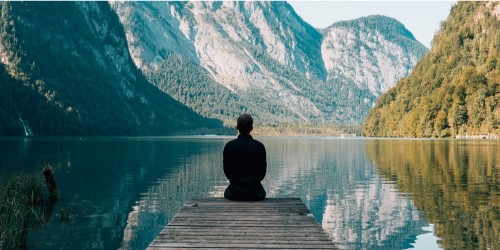
In the latest edition of MysticMag interviews, Christiane Michelberger, a seasoned physician-turned-spiritual guide, shares her profound journey through the 7 steps of awakening. With decades of experience in meditation and spiritual practice, she offers a no-nonsense approach to enlightenment, helping others navigate the often challenging but rewarding path to inner peace and self-realization. Continue reading to learn more.
In your work, you mention the 7 steps of awakening. Can you tell me what those 7 steps are?
Those seven steps are the process of awakening, which starts with seeing that there is no self as an agent, doer, or experiencer. We often think, “I decide, I experience, I see, I hear, etc.” However, the fundamental teaching of the historical Buddha helps us see clearly through these fetters, which are obstacles to enlightenment.
No Self as Agent: The first step involves realizing that there is no “me” doing anything. This step dismantles the illusion of a personal doer, leading to a profound sense of freedom.
Reactivity and Desire: The second step tackles our reactive nature to things we want or don’t want. By examining the space between our uncomfortable feelings of not getting what we (don’t) want and the reaction, it becomes clear that there is nothing that makes us react. This step often involves working through deep-rooted emotional issues, leading to the cessation of reactivity. When I went through this step, the very next day, everything bad that could’ve happened to me happened, but I didn’t feel anything. I had no reaction. The effects of this step can be felt very strongly, while the following steps are very subtle.
Subject-Object Duality: The third step addresses the assumption of a subject experiencing objects. Our attention moves quickly between objects and ourselves, creating a sense of duality. By seeing through this illusion, the sense of separation fades, and the world appears more unified. Not all is the same, but there’s no clear border between a tree and the observer of that tree. People going through this step might have difficulties perceiving distances between objects. Perception changes from 3D to 2D.
Perception: The fourth step involves recognizing that our perceived faculty of perception doesn’t exist as we think. The world appears but is not perceived. This realization challenges our understanding of the world, revealing that it isn’t perceived in the way we assumed. This step leads to the realization that time and space are illusions and that things aren’t substantial nor permanent.
Subtle Sense of Self: The fifth step is about finding and seeing through the very subtle sense of “I am” or “I exist.” This subtle sense of self dissolves, leading to a state where there is no identification with anything.
Restlessness: The sixth step is characterized by an intense restlessness. This restlessness searches for something to hold on to, but nothing can provide lasting satisfaction. This stage is about enduring and observing this restlessness until it naturally subsides.
Ignorance: The seventh and final step involves seeing through ignorance, the illusion that there is something unknown that could make us ultimately happy. However, in order for something to make us ultimately happy, it would have to be substantial and permanent, but such things don’t exist. When this last fetter drops, it becomes clear that our assumptions were mere ideas. The realization dawns that our delusions were always false, leading to a sense of profound clarity and ordinary existence.
These steps are detailed in my book, where I describe the entire process and my personal experiences. The journey through these steps leads to awakening and enlightenment, transforming our understanding and experience of reality.
Speaking of my books, I’m glad to say that I’ve written 2 books, “Finding Awakening – a No-Nonsense Buddhist Path to Peace and the End of Suffering” and “How to See Through the Self-Illusion – Instruction Manual”.
What were your professional beginnings like and what led you down this spiritual path?
In the beginning, I was a physician. My path started as a young physician in residency, which means I wasn’t yet fully qualified but was working in the job of a physician. One night, a severely injured motorbiker was brought into the ER, but he had already passed away. As the on-call physician, it was my job to examine him fully for legal purposes and to identify him. When I found his identity card, I saw that he was born in the same year as I was. At that moment, I realized the imminent reality of death and thought, “I don’t even know who I am.” This thought sparked a fire within me that never extinguished until my final awakening.
At that time, I was a young woman, freshly married, with no spiritual ambitions. I shared my experience with my husband, who suggested meditation. Two weeks later, an introductory course was announced, and I decided to participate. This marked the beginning of a 40-year journey of intense meditation and study under various teachers, including an Indian guru. Despite my efforts, I felt I hadn’t found the answer to my quest.
In 2015, I was diagnosed with breast cancer, which caused me to totally freak out. I felt my spiritual path had brought me nothing. The Buddha’s saying, “If you can’t control it, it can’t be you,” seemed meaningless to me. I realized I had been a spiritual sleepwalker and needed to find the truth now. I had exhausted all known paths and felt lost.
Two weeks later, a post on my Facebook feed led me to a platform specialized in the first step of awakening. I downloaded their book, which contained dialogues that asked profound questions such as, “Who is thinking?”, “Where is the thinker?” and “Who is seeing the tree outside?” After four days of engaging with these dialogues, I had a profound shift. While reading the question, ” Is there a you in any physical form or shape?” I realized there was no “me” and never had been. It felt like hitting a wall at 100 MPH. Everything turned silent, and I saw the obvious truth that there is no self. This realization left me feeling both astonished and foolish for not having seen it earlier.
I was in an altered state for a day, seeing everything in super 3D and vibrant colors. The world appeared empty yet beautiful. Despite initial concerns about connecting with people again, I decided to just enjoy the experience.
Realizing how simple and accessible this truth is, I felt compelled to help others see it too. Many in my circle had practiced Buddhism for decades without achieving stream entry, the first step in enlightenment. I got on this platform, confirmed my realization, and learned how to guide others.
Kevin Schanilec who developed a method for all the steps of awakening, guided me further. I am incredibly grateful for his guidance, which came at a time when I had fully given up hope. I didn’t expect anything to change in this lifetime, but it did. This journey led me to where I am now, guiding others on their path to awakening.
What is your understanding of awakening? What does it mean for a person to go through such an experience?
To me, awakening means realizing that there is no aspect of self whatsoever. This means all resistance to any experience is completely gone. It’s clear that whatever is experienced is just an appearance, not a substantial thing—it just appears in experience, similar to a dream.
When this becomes clear, there’s nothing left to resist. Engaging with dream content and saying “I don’t want that” is pointless because it’s already there. This non-reactivity and non-resistance bring a deep peace. Even when old emotional conflicts or traumas surface during the steps, they can be dealt with calmly and impersonally. It’s like debugging a computer—there’s no big fuss about it.
This state of awakening is such a gift that I wouldn’t exchange it for anything. For instance, after I completed my journey, I was diagnosed with another cancer. This time, the experience was entirely different. There was no reaction, just an acceptance of the situation. As a digital nomad living in a truck trailer over the summer, I realized that this diagnosis would change my immediate plans, but there was no distress. I simply figured out the best place for surgery and accepted the process.
Fortunately, it was an early-stage cancer, requiring no further treatment after surgery. Leaving the hospital, I felt as though I hadn’t suffered a scratch, despite the major abdominal surgery. It was an amazing and blessed feeling. Later, a lung lump was discovered, and while waiting for further scans, I remained unfazed. I considered that if it was a metastasis, I might have two to three years left. The only thing I felt compelled to do was to write a book about my experiences, to leave something lasting, and to keep this door open for others.
How is your guidance structured and what can people expect from it?
The most important thing to understand is that they are a hero’s journey, not a wellness program. Many people come to the spiritual path seeking to feel good, and while the end result brings peace and a sense of normalcy, the path itself can be quite turbulent. It requires mental and psychological resilience, as well as a certain level of life experience and functionality. Participants need to be able to handle daily life without significant emotional issues that impair their functioning, and they must refrain from using substances, as working with an altered brain isn’t feasible.
The journey can feel like a roller coaster. The inquiries we undertake might initially seem exciting, but as we progress, particularly when approaching the last sense of self, it can be daunting and evoke significant fear. It’s normal for people to move at their own pace, gaining courage as they go.
The process can be exhausting, often feeling like a complete internal restructuring while the external appearance remains unchanged. One client likened it to an old house being supported by poles to prevent collapse while undergoing renovations. Another client suggested that I should advise people to set aside money for potential unpaid leave during this period, as the journey can be very demanding.
Additionally, old traumas and emotions may surface as defense mechanisms weaken with the disappearance of the self. These issues are not resolved through the inquiry alone and must be addressed separately. This can continue even after awakening, with research by Jeffrey Martin suggesting that it may take up to seven years for all old issues to be resolved and for a new internal library to be established.
It’s important to know that this path is rocky and can evoke both extreme highs and lows. It’s exciting and feels incredibly good at times, but it can also feel really challenging. This journey is not for the faint-hearted but for those willing to embrace both the rewards and the challenges.
Can you share a memorable success story?
Yes, I have a memorable success story that I think is quite typical for people who are destined to succeed in this journey. It involves a woman I had met two years prior in a course about how to build a website. She was also a digital nomad, which is how we connected. After two years, she reached out to me and said, “Hey, Christiane, I want to do what you’re doing.” I asked her if she had ever meditated or had any spiritual practice, and she replied, “Yeah, I was in a Tibetan center one day.”
Despite or because of her limited background, the guiding process with her was incredibly smooth. She would work through the questions with her husband while traveling in their truck. Whenever she had internet access, she would report her progress, and everything went exceptionally well. She moved through the process thoroughly and effectively. Today, she is guiding others herself.
This story highlights an important point: the less people believe in spiritual concepts, the better they will progress. All beliefs are challenged in this journey, and clinging to them can cause people to get stuck. For instance, notions like “I am always blissful” can hinder progress. Many spiritual teachings promote a sense of fundamental well-being, but true awakening often leads to a very neutral, even state of being.
I experienced this myself while driving along the South Coast of the Isle of Wight, admiring the stunning white cliffs. Despite the beauty, it didn’t move me emotionally. It was the first time I noticed how neutral my feelings had become. This evenness is common among those who have truly awakened; the extreme emotional roller coasters of the past are replaced by a more stable state.
People who come with an “empty cup,” as the Zen folks say, without preconceived notions, tend to do the best. They are open to the journey unfolding in ways they couldn’t have imagined. This also means that they often realize they had misunderstood spiritual scriptures, which can only be truly comprehended through direct experience. Many times, I’ve found myself exclaiming, “Oh my God, the Buddha meant this literally!” It becomes clear that these teachings are literal truths, not metaphors, once you’ve seen them for yourself.
To learn more about Christiane’s work, you can visit findingawakening.com and www.unterwegsmitbuddha.de



